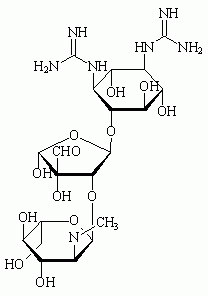 |
|
|
Streptomycin
|
|
| Systematic (IUPAC) name | |
|
5-(2,4-diguanidino-3,5,6-trihydroxy-cyclohexoxy)-4-
[4,5-dihydroxy-6-(hydroxymethyl)
-3-methylamino-tetrahydropyran-2-yl] oxy-3-hydroxy-2-methyl-tetrahydrofuran-3-carbaldehyde |
|
| Identifiers | |
| CAS number | 57-92-1 |
| ATC code | A07AA04 J01GA01 |
| PubChem | 19649 |
| DrugBank | APRD00412 |
| Chemical data | |
| Formula | C21H39N7O12 |
| Mol. weight | 581.574 g/mol |
| Physical data | |
| Melt. point | 12 °C (54 °F) |
Streptomycin is an antibiotic drug, the first of a class of drugs called aminoglycosides to be discovered, and was the first antibiotic remedy for tuberculosis. It is derived from the actinobacterium Streptomyces griseus. Streptomycin stops bacterial growth by damaging cell membranes and inhibiting protein synthesis. Specifically, it binds to the 16S rRNA of the bacterial ribosome, which prevents the release of the growing protein (polypeptide chain). Humans have structurally different ribosomes than bacteria, thereby allowing the selectivity of this antibiotic for bacteria. Streptomycin cannot be given orally, but must be administered by regular intramuscular injection. An adverse effect of this medicine is ototoxicity. It can result in permanent hearing loss.
Contents |
History
It was first isolated on October 19, 1943 in the laboratory of Selman Abraham Waksman at Rutgers University by Albert Schatz, a graduate student in his laboratory. Waksman and his laboratory discovered several antibiotics, including actinomycin, clavacin, streptothricin, streptomycin, grisein, neomycin, fradicin, candicidin, candidin, and others. Two of these, streptomycin and neomycin, found extensive application in the treatment of numerous infectious diseases. Streptomycin was the first antibiotic that could be used to cure the disease tuberculosis. Waksman is credited with having coined the term antibiotics.
The details and credit for the discovery of streptomycin were strongly contested by Albert Schatz and resulted in litigation. The contention arose because Schatz was the graduate student in charge of performing the lab work on streptomycin; however, it was argued that he was using techniques, equipment and lab space of Waksman's while under Waksman's direction. There is contention as to whether or not Schatz should have been included in the Nobel Prize awarded in 1952. However, the committee stated that the Nobel Prize was awarded not only for the discovery of streptomycin but also for the development of the methods and techniques that led up to its discovery and the discovery of many other antibiotics.
The litigation ended with a settlement for Schatz and the official decision that Waksman and Schatz would be considered co-discoverers of streptomycin. Schatz was awarded the Rutgers medal in 1994, at the age of 74. The controversy ultimately had a negative impact on the careers of both Waksman and Schatz and the controversy continues today.
Uses
- Tuberculosis in combination with other anti-TB drugs
- Yersinia pestis known popularly by one of its varients, the Bubonic Plague has been treated using this, Chloramphenicol, and Tetracycline.
References
- Kingston, William (2004). Streptomycin, Schatz v. Waksman, and the Balance of Credit for Discovery. Journal of the History of Medicine and Allied Sciences 59 (3), 441-462.
- Mistiaen, Veronique. Time, and the great healer. The Guardian, Saturday 2 November 2002. The history behind the discovery of streptomycin.
- Lawrence, Peter A. (2002). The misallocation of credit is endemic in science. Nature 415 (6874), 835-836.




 216.73.216.81
216.73.216.81 User Stats:
User Stats:
 Today: 0
Today: 0 Yesterday: 0
Yesterday: 0 This Month: 0
This Month: 0 This Year: 0
This Year: 0 Total Users: 117
Total Users: 117 New Members:
New Members:
 216.73.xxx.xx
216.73.xxx.xx
 Server Time:
Server Time: